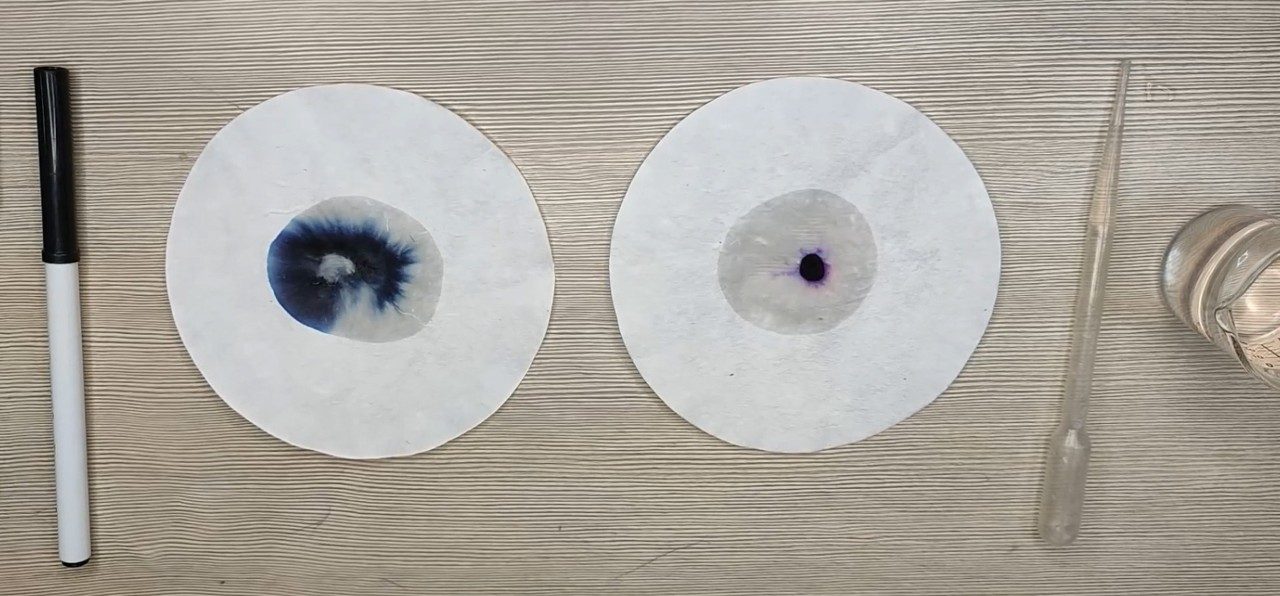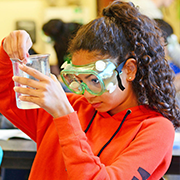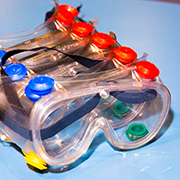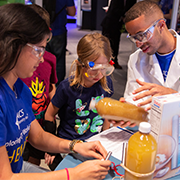Mystery Markers
Ages
5 - 12 years
Activity Time
Preparation: 10 mins
Activity: 5 - 10 mins (hands-on), 20 - 75 mins total
Group Size
* Participants work in pairs/trios
* 1 facilitator per 5 groups
ACS International Student Chapter at Bombay College of Pharmacy Presents: Mystery Markers
- Mixtures: Many markers contain a mixture of dyes to create their colors
- Intermolecular forces: Different dyes in markers are attacted to water and paper to different degrees
- Chromatography: Dyes in markers can be separated and identified using the different intermolecular forces between them, water, and paper
- Much of this activity is spent waiting for paper to dry. Prepare some samples in advance or have another activity for participants to do while they wait.
- Potential hazards include:
- Broken glassware
- Inhalation (isopropyl alcohol)
- Conduct your own RAMP assessment prior to presenting the activity.
Each group should be provided:
- 4 – 6 filter paper disks (2 per participant), plus 2 for presenter
- 2 – 3 primary (blue, red, or yellow) and 2 – 3 secondary colored (green, purple, or orange) water-soluble markers (e.g., EXPO® Vis-à- vis®)
- 3 black water-soluble markers of different brands (e.g., Crayola®, Mr Sketch®, Mondo™)
- ~50 mL water in a paper cup
- 2 – 3 pipettes
- Art supplies (optional):
- Hole punch
- Colorful yarn or string cut into 6-inch lengths
- Scissors
- Chenille wires or pipe cleaners
- Any additional materials identified in your RAMP analysis
Prior to Activity
Customize Activity to Venue
- Review RAMP safety worksheet
- Adapt procedure to your venue and participants
- List appropriate procedures for accidents, emergencies
Identify Safety Practices
- Wear personal protective equipment (goggles, gloves, etc.)
- Secure loose hair, clothing
- Prohibit eating, drinking
- Clean work area, wash hands after activity
- Additional practices identified in RAMP worksheet
Prepare Materials
- Collect sufficient materials for all participants.
On-Site
For each group:
- Provide 2 unmarked filter paper disks per participant, primary and secondary colored water-soluble markers, black markers, water-filled pipettes, and lids.
- Set out art supplies.
Additional set-up for your specific venue and audience (will vary).
-
Introduce Activity
Instructions
- Explain that participants will use paper to separate marker colors into their component dyes
- The techniques used today are similar to those chemists use to analyze materials
Talking Points
- What do you know about primary and secondary colors?
- What do you know about chromatography?
-
Make Separate a Secondary Color
Instructions
Direct participants to:- Choose a primary (blue, red, or yellow) and secondary-colored (green, purple, or orange) marker.
- Draw a few dots in the center of a filter paper disk.
- Use a pipette to squeeze a few drops of water onto the filter paper directly onto the design.
- Explain how chromatography separates the components of the markers (see Explore the Chemistry).
Talking Points
- What do you guess will happen when you add water to the paper?
- What actually happens to the ink as the water and moves on the paper?
- Compare the two colors. How are they different?
-
Compare the Color Separation of the Black Markers
Instructions
- Choose two of the three black markers.
- Draw an pea-sized dot in the center of a new piece of filter paper.
- Add a few drops of water.
Explain how chemists use chromatography to identify the components of the markers (see Explore the Chemistry).
Talking Points
- Now what colors do you see?
- What are the differences among the black markers?
- Which black marker were you using?
-
Create Your Own Art (Optional)
Instructions
Direct participants to:- Use the art supplies to create bookmarks, butterflies, or other art
Talking Points
- What other products, besides markers, could you analyze using paper chromatography?
-
Clean Up
Instructions
- Dispose of all solids in the trash.
- Pour all remaining liquids down the drain.
- Wipe all work surfaces clean with water or a damp cloth.
- Wash hands thoroughly.
Here are some key themes to explore with the audience once they've completed the activity. Adjust the details to match the level of your audience.
What is chromatography?
This activity uses an analytical technique called paper chromatography. The word "chromatography," was first used by Russian chemist Mikhail S. Tsvet, who combined the Greek words for "color" and "writing" to describe the technique he used to separate mixtures of colored compounds.
Chromatography separates mixtures of compounds by passing a solution containing the mixture, called the "mobile phase" over a non-moving material, called the "stationary phase." In this activity, water is the mobile phase and the filter paper is the stationary phase.
As the mobile phase moves over the stationary phase, it carries the marker pigments with it. Pigment molecules move at different speeds depending on the size of the molecule and how attracted it is to the paper vs. the water. These differences cause the pigments to separate.
Separating secondary colors
Primary colors typically use one pigment, but secondary colors are made by mixing many different colors. For example, purple, which frequently relies on the food dyes Red #40 and Blue #1, separates into red and blue on the paper. (You can also use chromatography to analyze food dyes in drinks and candy.)
Separating black markers
All of the different marker brands in this activity look black on the paper, but each company uses a unique mix of pigments. Chromatography reveals which colors combine to make which black marker.
Applications of chromatography
Chemists use a variety of compounds for the mobile and stationary phases to separate and analyze parts of mixtures with chromatography. Tsvet's original work used alcohol for the mobile phase and silicon dioxide to the stationary phase to separate the pigments that give plants their colors and show how they break down in cooler weather.
Chromatography can also be used by law enforcement in crime scene investigations, by art experts to determine original paint pigments in restoration projects, and even when analyzing food.
References
- American Chemical Society, 2023
- ACS International Student Chapter at Bombay College of Pharmacy
- Adapted from "Chemistry is Colorful" module of the Let's Do Chemistry series developed by the National Informal STEM Education Network, 2018. https://www.nisenet.org/catalog/chemistry-colorful (accessed September 2023)





